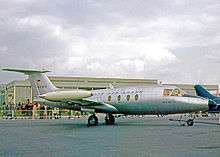Hamburger Flugzeugbau HFB-320 Hansa Jet
| HFB-320 Hansa Jet | |
|---|---|
 | |
| Hamburger Flugzeugbau HFB-320 Hansa Jet of the Luftwaffe at Basle Airport | |
| Role | Business jet |
| National origin | Germany |
| Manufacturer | Hamburger Flugzeugbau |
| First flight | 21 April 1964 |
| Retired | 24 June 1994 |
| Primary user | West German Air Force |
| Number built | 47[1] |
The Hamburger Flugzeugbau HFB-320 Hansa Jet is an all-metal, twin-engine, ten-seat business jet that was built by German aircraft manufacturer Hamburger Flugzeugbau between 1964 and 1973.
The most notable feature of the aircraft is its forward-swept wing, which is mid-mounted in the fuselage. This arrangement allows the wing spar to pass through the fuselage behind the passenger cabin without decreasing cabin volume. As of 2011, it remains the only civilian jet ever to use a forward-swept wing.
Development


The prototype first flew on 21 April 1964 and was exhibited at the May 1964 Hanover Air Show. A second prototype was flown on 19 October 1964.[2] After a year of certification flight testing, the first prototype crashed on 12 May 1965, due to a design fault with the T-tail.[3] Hamburger Flugzeugbau's chief test pilot perished in the crash. As a result of the accident, modifications were made to improve the aircraft's stall performance, including a stick pusher.
Assembly of the first ten production aircraft began in May 1965, with the first flying on 2 February 1966. German type certification was achieved on 23 February 1967, with American certification following on 7 April 1967. Italcementi of Italy took first customer delivery on 26 September 1967.[4] Other corporate purchasers of the HFB-320 included the Argentinian state-owned Yacimientos Petroliferos Fiscales oil company.
The German Air Force had ordered 13 HFB-320s in 1963. As part of the evaluation of the type, two preproduction aircraft were delivered to the ErpSt 61 test wing at Oberpfaffenhoffen in 1966.[1][5] This resulted in six aircraft being ordered for VIP use by the German Air Force.[1] Production deliveries for use as VIP transports commenced in 1969.
A further eight Hansa jets were purchased by the German Air Force for ECM training, these being delivered between August 1976 and April 1982. The German Air Force replaced its VIP Hansas with Canadair Challengers in 1987, but the ECM aircraft remained in service until 1994.[6]
Increased competition from newer executive jet models and a comparatively poor safety record led to dwindling orders, with production ceasing in 1973. The Aviation Safety Network lists a total of nine accidents (six fatal) for the type,[7] a 20 percent hull-loss rate, but only the crash of the prototype was directly attributable to the aircraft's design. Pilot error was blamed in a majority of the accidents.
Operators
Civilian Operators
- Golden West Airlines - this southern California-based commuter airline operated scheduled Hansa Jet passenger service from Burbank Airport (BUR, now Bob Hope Airport) to Santa Barbara (SBA) and Palm Springs (PSP) in 1969
- Modern Air Transport
Military operators
Specifications (HFB 320)
Data from [8]
General characteristics
- Crew: two
- Capacity: 7, 11 or 15 passenger configurations
- Length: 16.61 m (54 ft 6 in)
- Wingspan: 14.48 m (47 ft 6 in)
- Height: 4.92 m (16 ft 2 in)
- Wing area: 30.14 m² (324.4 ft²)
- Empty weight: 5,511 kg (12,125 lb)
- Max. takeoff weight: 9,218 kg (20,280 lb)
- Powerplant: 2 × General Electric CJ610-5[9] turbojet engines, 13.15 kN (2,950 lbf) each
Performance
- Cruise speed: 825 km/h (445 knots, 513 mph) at 25,000 feet (7,620 m)
- Range: 2,413 km (1,303 nm, 1,500 mi)
- Service ceiling: 11,433 m (37,500 ft)
- Rate of climb: 21.6 m/s (4,250 ft/min)
See also
- Aircraft of comparable role, configuration and era
- Related lists
References
| Wikimedia Commons has media related to HFB-320 Hansa Jet. |
- Notes
- 1 2 3 Sloot 1994, p. 234.
- ↑ Taylor 1965, p. 74.
- ↑ Hansa accident
- ↑ Taylor 1969, p. 97.
- ↑ "HFB 320 HANSA JET". hansajet.de. Retrieved 22 June 2011.
- ↑ Sloot 1994, pp. 234–235.
- ↑ HFB 320 Hansa Accident Summary
- ↑ Green, William, The Observers Book of Aircraft, Frederick Warne & Co. Ltd, 1970. ISBN 0-7232-0087-4
- ↑ The first 15 production units used General Electric CJ610-1 engines; the next 20 units used the more powerful CJ610-5; subsequent units used the CJ610-9.
- Bibliography
- Mondey, David (1982). Encyclopedia of the World's Commercial and Private Aircraft. New York City: Crescent Books. p. 201.
- Sloot, Emiel. "Hansa Jet Retirement". Air International, October 1994, Vol 47 No 4. pp. 234–235. ISSN 0306-5634.
- Taylor, John W. R.. Jane's All The World's Aircraft 1965–66. London: Sampson Low, Marston & Company, 1965.
- Taylor, John W. R.. Jane's All The World's Aircraft 1969–70. London: Sampson Low, Marston & Company, 1969. ISBN 0-354-00051-9.